Blue River Quakers and the Abolitionist Movement
Since 1776, Quakers had forbid their members from owning slaves and were advocates for equality, regardless of sex or race. Quakers became part of the underground railroad because they were convinced that they were right in God's sight, even though they knew they were breaking man-made laws.
The earliest report of a runaway slave in the Salem area goes back to 1819. Undoubtedly, the little information we have gleaned about the clandestine operation of the underground railroad in Washington County, would have actually went back another generation. Most of the information gathered over the operation and its participants was from the descendants of the active members, during its heyday, not the members themselves. Additionally, by the time stories/traditions began to publicly come out about the county's operation, all of our former black citizens had relocated away, or were unjustly encouraged to leave the area. Their levels of involvement and activities in the operation were lost at an early date and are therefore poorly represented in the overall scheme. So by no means can we give a detailed accurate account of the operation in this county, nor are we able to explicitly say that these were the only routes/station houses/conductors who participated.
Quakers Face a Crossroads based on their beliefs
An ordinance for the government of the Northwest Territory, passed by Congress in 1787, prescribed that "There shall be neither slavery nor involuntary servitude in the said territory, otherwise than in punishment of crimes, whereof the party shall have been duly convicted." This same article was incorporated in the state constitution in 1816.
With the passage of this new law many people emigrated to the territory that did not wish to take up a residence in slave-holding territory. By the mere act of remaining in North Carolina and areas of the south, Quakers were giving tacit approval to a system that enslaved a fellow man. Thus, they turned their backs to their friends, communities and homes in the Carolinas and other parts of the south.
Blue River Quakers and the Fugitive Slave Law
The Quakers formed settlements throughout the territory, like the one in Salem, and all were bitterly opposed to slavery. They considered the fugitive slave law of 1850 cruel and oppressive, and a blot upon the fair name of the state. It provided that "If any person, without proper authority, shall give to anyone owing service in any state or territory within the United States, a certificate or other testimonial of emancipation, or shall knowingly harbor or employ any such one owing service as aforesaid, or held as a slave, who may have come into this state without the consent of his or her owner, or shall encourage or assist any such one to desert or not go with her or her owner, or shall use any violence or other means to prevent, let, or hinder any person in lawfully recovering any fugitive slave or person owing service, such person so offending shall, upon conviction thereof, be fined in any sum not exceeding five hundred dollars, and be liable for damages to any person or persons injured by any of said acts."
Results of the Fugitive Slave Act
Instead of being a help to owners of fugitive slaves, as it was intended, this law was in fact a hindrance, for it proved to be an incentive to a more determined effort on the part of those who persisted in fomenting the "irrepressible conflict" Harriet Beecher Stowe had graphically pictured in "Uncle Tom's Cabin" the life of slavery, and the aspirations burning in the human quest for freedom, yet there were those in our midst before his time who has seen, heard and could recite details of battles for liberty and life itself as stirring as any in the experiences of "Uncle Tom". It was a fact that Mrs. Stowe was implored by some of the Indiana Quakers to use her marvelous literary abilities on behalf of slaves, and she got some of them the story of Eliza, which she took as a foundation for her great work.
Blue River Quakers and the Underground Railroad
There was probably no more peculiar institution known to the early history of Washington County than the "underground railroad". It was the connecting link between slavery and freedom. There were conductors all along the mysterious route, earnest and active in their work, and stations were established at convenient points from the Ohio River all the way to Canada.
Between 1820 and 1860 several hundred slaves were delivered from bondage through this route and only a few were captured and returned to bondage once they got connected to the underground railroad. Slave hunters nearly always found themselves outwitted and outgeneraled by the cautious anti-slavery men and women.
In the earliest days, the leaders of the Underground Railroad in Washington County, Indiana were unknown, but from some time in 1836 or near that time the leaders were William Penn Trueblood, James L. Thompson, Joshua Trueblood and Elwood Trueblood.
Underground Railroad Sites in the Blue River Quaker Settlement
James L. Thompson Stationhouse
Even though the Thompson's reportedly assisted hundreds of fugitives along the underground railroad, James only ever lost 2 passengers, in a slave hunter's ambush, and was never brought up on formal charges. They were said to have had hundreds of letters in their possession, from runaways who had written to express their appreciation, once they had reached their freedom.
William Penn Trueblood Stationhouse
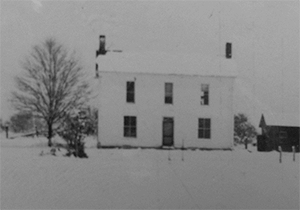 His house was constructed in the early 1850's and is still standing today. It appears to have had a walled off room, in one corner of the basement and in an upstairs closet, you can find a secret narrow passage way, extending about 10 feet in length that leads to a secret walled off room, with no windows and crude wooden bunk bed frames fastened to the east and west walls. From an outside observation of the home, you would never realize this room existed. We cannot picture the large straw stacks piled up over rail pens that formed the frequent and secure hiding places for the many fugitives he assisted in the flight to freedom.
His house was constructed in the early 1850's and is still standing today. It appears to have had a walled off room, in one corner of the basement and in an upstairs closet, you can find a secret narrow passage way, extending about 10 feet in length that leads to a secret walled off room, with no windows and crude wooden bunk bed frames fastened to the east and west walls. From an outside observation of the home, you would never realize this room existed. We cannot picture the large straw stacks piled up over rail pens that formed the frequent and secure hiding places for the many fugitives he assisted in the flight to freedom.
Elwood Trueblood Stationhouse
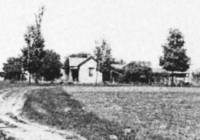 The life of Elwood Trueblood and his ministry is chronicled in the book Prophet of Blue River that was published in 1914 by the Society of Friends.
The life of Elwood Trueblood and his ministry is chronicled in the book Prophet of Blue River that was published in 1914 by the Society of Friends.
Click on the link below to view this publication.
Nathan Trueblood Stationhouse "Cypress Hill"
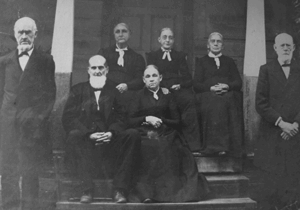 Nathan built a beautiful and substantial home in the Blue River Friends settlement area named "Cypress Hill". It was a long, two-story frame building facing south. A veranda ran the whole length of the south side of the building, which was usually painted white. The homestead was named Cypress Hill because of a cypress tree which had been planted by Elizabeth, the eldest daughter. Four seeds had been brought from North Carolina; from one of the seeds grew the very large tree which symbolized this strong and vital family of pioneers. The house stood on a hill from which a beautiful view of the county could be seen.
Nathan built a beautiful and substantial home in the Blue River Friends settlement area named "Cypress Hill". It was a long, two-story frame building facing south. A veranda ran the whole length of the south side of the building, which was usually painted white. The homestead was named Cypress Hill because of a cypress tree which had been planted by Elizabeth, the eldest daughter. Four seeds had been brought from North Carolina; from one of the seeds grew the very large tree which symbolized this strong and vital family of pioneers. The house stood on a hill from which a beautiful view of the county could be seen.
Cypress Hill was also called the "Mount Vernon of Washington County" and was known for hospitality. Some orphans sought sought shelter there and were carefully reared by Nathan and Patience Trueblood. Nathan and Patience's Cypress Hill was a mecca not only for the young and old folks in the area; it was also a resting place for traveling ministers of the friends and negro fugitives on their way north to freedom.
Stationhouse of James "Little Jimmie" Trueblood
James married his 3rd cousin, Elizabeth Trueblood, (sister of William Penn Trueblood), in 1815, in North Carolina and for their honeymoon the couple hit the Wilderness Trail, bound for the Indiana Territory. This Quaker couple built their home with logs from an abandoned fort they found on a nearby property.
Noted historically as a lieutenant for the Thompson Line of the underground railroad, it was said that what "Little Jimmie" lacked in stature: he made up for in heart and nerve. He was a teacher and a farmer, as well as a fervent abolitionist, who was not afraid to speak his mind on the subject, regardless of the company he was in and he refused to use any material or products manufactured, in any respect, from slave labor.
Little Africa Neighborhood
This neighborhood sprang up in the 2nd addition Charles Hay added to the town of Salem in the late 1830's. It was bordered by East Market Street to the south, Blue River, to the east, Hay's Avenue from the west and Hackberry Street to the North, some years later it was bisected by the railroad. Several of the residents here were known conductors on the underground railroad operation and served as stationmasters in times of necessity. After 1851, some runaway slaves were reputed to have ridden into towns on the trains, jumping off in the "Little Africa" neighborhood to meet conductors, who guided them out to the Quaker Thompson Line.
Related Information - African American Community in neighboring Orange County
William B. Lindley House
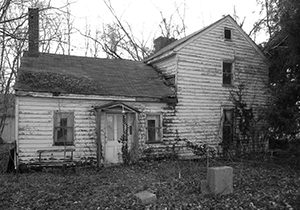 The William B. Lindley house, built around 1814, was in the Lindley family for more than 150 years, and was one of the slave stations. Viola Lindley, well known artist, educated in Paris and New York, was the last in the family who lived and died in the house, which is built of logs.
The William B. Lindley house, built around 1814, was in the Lindley family for more than 150 years, and was one of the slave stations. Viola Lindley, well known artist, educated in Paris and New York, was the last in the family who lived and died in the house, which is built of logs.
Stationhouse of the Lindley Family
The Lindley's were Quakers from Winston-Salem, North Carolina who were stout believers in equality. Their property, built in the 1850's, went from Samuel and Mary (Braxton) Lindley, to their son, William and his wife, Martha (Hollowell) Lindley, as likely did their activities in the Underground Railroad.
Trueblood Mill (Canton Mill)
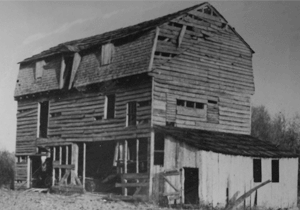 Established in 1820 by Nathan Trueblood, this mill was operating under his son, William Nathan's management during the highest activity of the Underground Railroad. Situated on Old Canton Road, it was just southeast of the Blue River Quaker Neighborhood, an easy landmark for unfamiliar passengers to pick out. William Trueblood had an employee and his family living in the mill from the 1840's, until around 1860. This man was an Indiana born, free black man, named George Washington "Wash" Parker, who was a known conductor, who assisted fugitives to the Thompson Line.
Established in 1820 by Nathan Trueblood, this mill was operating under his son, William Nathan's management during the highest activity of the Underground Railroad. Situated on Old Canton Road, it was just southeast of the Blue River Quaker Neighborhood, an easy landmark for unfamiliar passengers to pick out. William Trueblood had an employee and his family living in the mill from the 1840's, until around 1860. This man was an Indiana born, free black man, named George Washington "Wash" Parker, who was a known conductor, who assisted fugitives to the Thompson Line.
Underground Railroad Points of Interest in the Blue River Quaker Settlement
James L. Thompson, A Leader for the Underground Railroad in Washington County
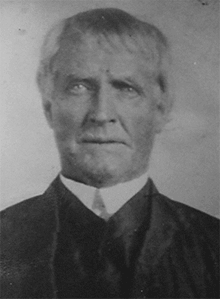 Among the Quakers, who were all in sympathy with the workings of the Underground Railroad, James L. Thompson was the acknowledged head. His home was located about four miles northeast of Salem in the Blue River Quaker Settlement.
Among the Quakers, who were all in sympathy with the workings of the Underground Railroad, James L. Thompson was the acknowledged head. His home was located about four miles northeast of Salem in the Blue River Quaker Settlement.
James was 6 years old when he came to Washington County, in 1810, with his parents, Levi and Jane (Nicholson) Thompson, from North Carolina. His mother became an early influential minister in the Quaker Church.
James was one of the very few involved with the Underground Railroad, who spoke somewhat freely about his experiences, after the Emancipation Proclamation. He indicated to several people that his parents had been involved, with assisting runaway slaves, long before he was old enough to do so. He recollected from his childhood, taking cornbread muffins and boiled eggs that his mother had made, to the fugitives in their places of concealment, as being his first involvement in the operation.
In 1826, James married Sarah "Sally" Towell, from Orange County and they constructed a home on his father's property, on Section 2 of
Washington Twp., where they remained for the rest of their lives. Their "stationhouse" was another home that had a walled off, secret room, in the basement and access to the room was through a hidden trap door, under their kitchen table. Additionally, they too were said to have had another secret room, in the attic of the house, similar to the upstairs room described at William Penn Trueblood's home.
His wife proved to be a very energetic worker in the cause, and always had food and clothing prepared for the hungry and perhaps half-naked fugitives that were likely at any moment, especially at night, to knock at the door and introduce themselves with the remark, "We have heard that you were good to the like of us and have been sent to your house."
James and Sally probably assisted and transported more fugitive slaves than anyone else in the county over their tenure of activity. They were said to have had hundreds of letters in their possession, from runaways who had written to express their appreciation, once they had reached their freedom. What ever became of those historically significant correspondences is unknown.
William Penn Trueblood, A Leader for the Underground Railroad in Washington County
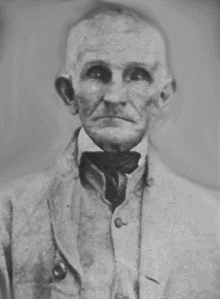 William migrated to Washington County in 1815, at 15 years of age, with his parents and siblings, settling in the old Blue River Friends Settlement. The Truebloods were Quakers from North Carolina that opposed slavery. Several members of the Trueblood family became heavily involved in the overall operation of the underground railroad through Washington County, Indiana
William migrated to Washington County in 1815, at 15 years of age, with his parents and siblings, settling in the old Blue River Friends Settlement. The Truebloods were Quakers from North Carolina that opposed slavery. Several members of the Trueblood family became heavily involved in the overall operation of the underground railroad through Washington County, Indiana
In 1821, William Penn was united in marriage to Ann White, at the Old Blue River Friends Meeting House and she would join him in his conspiratorial efforts to assist runaway slaves in their endeavor for freedom.
William was primarily a farmer, but one who was very interested and involved with the advancement of horticulture. Secretly, he was also, the Head of the Washington County Underground Railroad Advisory Board, a station master and conductor on the Thompson Line.
William was described as methodically intelligent, stoic, honest and faithful. These qualities would have been extremely advantageous on counseling the comprehensive management of the operation in the county. The scope of his importance to the overall operation will never be fully understood, but cannot be understated, when looking at the success the route had through the county.
Dangers faced by Underground Railroad Conductors
With every new face that presented itself at a station of the underground railroad there arose a multitude of questions in the mind of the conductor. Were the fugitives being pursued? Were slave hunters close by? Was it a slave-owner or professional slave hunter? Were the fugitives advertised? Were they posted in Indiana or Washington County? What was the reward for their capture?
T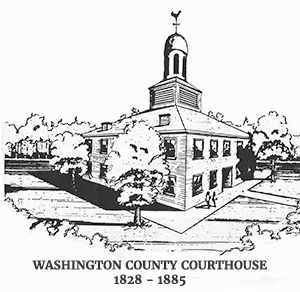 hese were among the questions that were set revolving in the mind of the individual assisting the runaway slave. To say that the doors were always to runaway slaves might not be strictly true, but they were soon made to feel friends were caring for them. The station was always under the threat of suspicion, and when the slave hunter came along it was soon pointed out to the conductor. So, until the necessary bearings were taken it was usual to lodge these fleeing people in straw and fodder racks, wheat shocks, secluded places in the woods, haymows, outhouses, secret rooms or cellars.
hese were among the questions that were set revolving in the mind of the individual assisting the runaway slave. To say that the doors were always to runaway slaves might not be strictly true, but they were soon made to feel friends were caring for them. The station was always under the threat of suspicion, and when the slave hunter came along it was soon pointed out to the conductor. So, until the necessary bearings were taken it was usual to lodge these fleeing people in straw and fodder racks, wheat shocks, secluded places in the woods, haymows, outhouses, secret rooms or cellars.
Having learned the name of the newcomer the next thing to do was to go to Salem, inspect the walls of the courthouse and see if any posters were up and look at the papers for the descriptive advertisement that usually followed in such cases. If in a few days it developed that the fugitive had eluded the vigilance of his pursuers, he was taken into closer communion, perhaps given a few days' work to earn money to help him on his way, when he was soon after piloted to the next station. If he was hotly pursued, the greatest care was exercised in selecting a hiding place, or he was spirited away between two days under the care of a trustworthy guide and perhaps along some unfrequented highway to a place of safety.
Moving on to the Next Stations
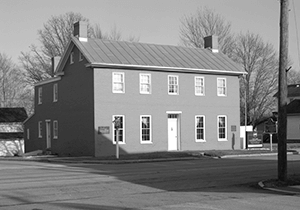 Station No#2 was located at Farmington, Jackson County, and was managed by Richard Cox. Station No#3 was at Azalia in Bartholomew County, in the charge of John Thomas. The next point was located near Franklin and hence the route lay a little east of Indianapolis and through to Canada, there being regular stations at intervals all along the way. Another route from Azalia was through Decatur, Franklin and Fayette counties to Levi Coffin's at Newport, Wayne County. Levi Coffin was by general consent called the president of the underground railroad.
Station No#2 was located at Farmington, Jackson County, and was managed by Richard Cox. Station No#3 was at Azalia in Bartholomew County, in the charge of John Thomas. The next point was located near Franklin and hence the route lay a little east of Indianapolis and through to Canada, there being regular stations at intervals all along the way. Another route from Azalia was through Decatur, Franklin and Fayette counties to Levi Coffin's at Newport, Wayne County. Levi Coffin was by general consent called the president of the underground railroad.
For more information on the Abolitionist movement in Washington County please visit the Stevens Museum at the John Hay Center in Salem Indiana.

